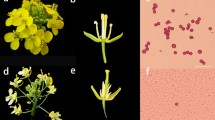Abstract
HAPLOIDS are valuable for new approaches to genetic, cytogenetic and breeding research in plants such as cultivated alfalfa, Medicago sativa L., which behave as auto-tetraploids. Their use is limited in this species, however, by the lack of a technique for their isolation; only three haploids have been reported1–3. Recently, we isolated eight haploids (2n = 2x = 16) from cultivated alfalfa (2n = 4x = 32) among the progeny of 4x−2x crosses, designed to facilitate the detection of haploids. Thus 4x−2x crosses provide a simple and effective method of obtaining alfalfa haploids.
Similar content being viewed by others
References
Lesins, K., Canad. J. Bot., 35, 181 (1957).
Stanford, E. H., and Clement, W. M., Agron. J., 50, 589 (1958).
Clement, W. M., and Lehman, W. F., Crop Sci., 2, 451 (1962).
Davis, W. H., and Greenblatt, I. M., J. Hered., 58, 301 (1967).
Bingham, E. T., Crop Sci., 8, 760 (1968).
Peloquin, S. J., Hougas, R. W., and Gabert, A. C., in Chromosome Manipulations and Plant Genetics (edit. by Riley and Lewis), 21 (Oliver and Boyd, Edinburgh, 1966).
Author information
Authors and Affiliations
Rights and permissions
About this article
Cite this article
BINGHAM, E. Haploids from Cultivated Alfalfa, Medicago sativa L.. Nature 221, 865–866 (1969). https://doi.org/10.1038/221865a0
Received:
Revised:
Issue Date:
DOI: https://doi.org/10.1038/221865a0
- Springer Nature Limited
This article is cited by
-
RETRACTED ARTICLE: Doubled haploid production in alfalfa (Medicago sativa L.) through isolated microspore culture
Scientific Reports (2019)
-
Apomictic maternal diploids in tetraploid Job's tears
Theoretical and Applied Genetics (1975)
-
Diploid parthenogenesis and androgenesis in diploid Solanum
Euphytica (1972)
-
Chromosome behaviour and fertility of the raw and evolved synthetic tetraploids of pearl millet,Pennisetum typhoides stapf et hubb.
Genetica (1970)





